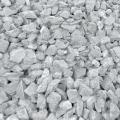What types of crushed stone are there?
Types of crushed stone
Perhaps no construction is complete without the use of crushed stone. This applies to the construction of residential premises, administrative buildings, the construction of bridges, laying roads, runways, etc. However, in each case a certain type of crushed stone is required. The purpose of the article is to convey to the site visitor information about what types of crushed stone there are.
According to the method of extraction and production, it is divided into the following types:
- Granite.
- Gravel.
- Limestone.
- Secondary.
- Slag.
Granite crushed stone
Granite crushed stone is extracted from rocks that have a granular structure. As is known, most of the mountains on the planet were formed as a result of solidified magma thrown to the surface during volcanic eruptions, and consisting of the elements of mica, feldspar and quartz. The predominance of one of these crystals over the others determines the color of the rubble, which can be red, pink or gray.

Granite crushed stone of various fractions
Granite boulders that are formed as a result of blasting operations are crushed in special equipment, then it is sifted and separated into fractions, among which are:
a) large fractions;
b) middle fractions;
c) small fractions;
d) and granite screening.
Each fraction has its own characteristics and finds its place in the production of reinforced concrete structures, in the construction of residential and administrative buildings, as well as for laying road surfaces. Granite screenings are often used for decorative purposes for paving paths and arranging flower beds. The largest fractions of granite crushed stone, which are called “rubble stone,” are used for laying the bases of stone fences and metal fences.
The cost of granite crushed stone directly depends on its size: larger fractions will cost less than their small “brothers” for the reason that the production of the latter requires more costs for crushing the material.
Crushed gravel is obtained by sifting quarry rocks, so it is classified as non-metallic stones. Visually, it differs from crushed granite in its more rounded shape and, although crushed gravel has less strength compared to its granite counterpart, it is a very environmentally friendly material.
The technical characteristics of crushed gravel are as follows:
Strength ranges from M600 to M1200.
Flakiness from 7 to 17%.
Frost resistance F150

Crushed gravel of various fractions
An important characteristic of crushed gravel is the size of its fractions, which, based on this, have different applications. For example, fractions up to 5 mm are used for decorative and landscape work, values up to 10 mm are used for the production of concrete and foundation construction, but perhaps the most popular fraction among builders is up to 20 mm, which is used for the manufacture of foundations. Larger fractions up to 150 mm are also used, which, as in the case of crushed granite, are used for laying the base of a stone fence.
In principle, crushed gravel finds its application similarly to granite crushed stone, but due to its comparatively lower cost and environmental friendliness it is more in demand among private housing builders.
At its core, crushed limestone (or dolomite) is the result of crushing sedimentary rocks that form plates lying in the earth's crust. The basis of crushed stone is calcium carbonate, obtained from the remains of animals, plant remains and various chemical impurities. These components significantly impair the strength of crushed limestone, but it has good frost resistance, can withstand temperature changes and, in addition, is low in cost.

All these qualities make it possible to use it in the construction of road embankments with low congestion. When landscaping an area, many prefer to use this type of crushed stone due to its environmental friendliness and lack of radioactive background. In the chemical industry, it is used to produce soda, mineral fertilizers, and calcium carbide, from which methane gas is then produced in gas generators for gas welding and gas cutting.
Many people are interested in the question: is it possible to use crushed limestone for arranging foundations, producing concrete, and pouring formwork? Specialists in the field of construction do not exclude this possibility, but on the condition that the characteristics of gravel are carefully studied, other proportions of the structures are precisely calculated: sand, and various additives.
Recycled crushed stone is produced from waste from crushing granite crushed stone, which makes it a significantly inexpensive product used to reduce the cost of construction, since its parameters are close to its granite analogue. In turn, secondary crushed stone, depending on the waste from which it is produced, is divided into concrete crushed stone (crushed concrete) and asphalt chips.

Recycled crushed stone of various fractions
Crushed concrete is widely used for constructing foundations, constructing road embankments, pouring open areas, making concrete, and also strengthening slopes to combat landslides.
Taking into account such qualities of secondary crushed stone as water resistance and frost resistance, it is widely used in the construction of pipeline cushions and other water structures.
In order to obtain slag crushed stone, slag from the metallurgical industry is used, which is crushed or undergoes special processing. During the crushing process, three fractions are distinguished: small, medium and large, and if the dimensions are considered in mm, we get granules: 5 - 10 mm, 10 - 20 mm, 20 - 40 mm, 40 - 70 mm and 70 - -120 mm. To date, types of concrete with slag fillers have been developed that are in no way inferior to concrete with fillers of other crushed stone analogues. Moreover, the cost of such products is 20 - 30% lower than traditional ones.

Crushed slag stone from steelmaking slags .
Along with waste slag crushed stone, porous crushed stone is also produced, which is formed from alloys with high oxygen saturation. However, slag porous crushed stone is inferior in strength and bulk density to its “brother”. If the density of dump crushed stone is 1000 kg/m³, then for porous gravel this value is 800 kg/m³.
Perhaps the most famous use of crushed slag stone is in the manufacture of cinder blocks. But the scope of application of the material is not limited to this. It is used in the production of asphalt and concrete, in the manufacture of reinforced concrete structures, and sand-lime brick, in the construction of roads.
 Construction materials and list of works
Construction materials and list of works Proper insulation of a wooden ceiling in a private house
Proper insulation of a wooden ceiling in a private house What types of crushed stone are there?
What types of crushed stone are there?